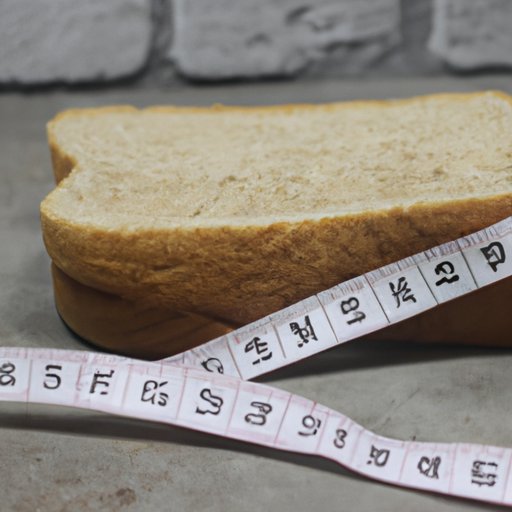
Introduction
When it comes to weight loss, bread is often considered a food to avoid. With many popular diets, like the keto or paleo diet, recommending eliminating bread altogether, it’s easy to see why this perception exists. However, the reality is that bread can actually be a valuable addition to a weight loss diet when chosen and consumed correctly.
In this article, we’ll explore the truth about bread and weight loss, including the nutritional benefits of certain bread types, the importance of portion control, the pros and cons of eliminating bread from your diet, the best and worst breads for weight loss, and how incorporating bread into an exercise plan can aid in weight loss.
The Surprising Truth: How Bread Can Actually Help You Lose Weight
While not all bread is created equal, certain types of bread can provide valuable nutritional benefits that enable weight loss. Whole grain bread, for example, is a great source of fiber and complex carbohydrates, which can help you feel full and satisfied for longer periods, ultimately preventing overeating and aiding in weight loss. Similarly, sourdough bread contains probiotics, which promote digestive health, and a low glycemic index, which helps regulate blood sugar levels and prevent cravings for less healthy foods.
To incorporate bread into a healthy, balanced diet, choose breads that are made from whole, unprocessed ingredients and avoid those that contain added sugars, refined flour, or preservatives. Consider pairing your bread with nutrient-dense foods like lean protein or healthy fats to maximize the nutritional value of your meal.
Bread Doesn’t Have to Be the Enemy: The Importance of Portion Control
While bread can be a valuable part of a weight loss diet, it’s important to exercise portion control to avoid consuming too many calories. However, not all bread is high in calories. For example, one slice of whole wheat bread typically contains around 80 calories, while a slice of white bread contains about 75 calories. Choosing a smaller or thinner slice of bread or opting for an open-faced sandwich can also help reduce calorie intake.
To make your consumption of bread work for your weight loss goals, consider pairing it with protein or healthy fats, like avocado or nut butter. Doing so can help slow digestion and prevent blood sugar spikes that may lead to unhealthy cravings or overeating.
The Bread-Free Diet: The Pros and Cons of Eliminating Bread from Your Meals
In recent years, eliminating bread from one’s diet has become a popular weight loss trend. While this approach may work for some, it’s important to consider its pros and cons. By eliminating bread, many individuals may reduce their overall carbohydrate intake, which can lead to weight loss. However, it’s important to remember that bread can be a valuable source of fiber and other nutrients that support weight loss. Eliminating bread may also make it harder to sustain a long-term healthy lifestyle, as many individuals find difficulty sticking to a restrictive diet.
Ultimately, the decision of whether or not to eliminate bread from your diet should be based on your personal goals and preferences. If you do choose to eliminate bread, be sure to find other healthy sources of fiber and carbohydrates to supplement your diet, like fruits, vegetables, and legumes.
The Best and Worst Breads for Weight Loss: A Comprehensive Guide
When it comes to making the best bread choices for weight loss, not all breads are created equal. Here’s a breakdown of different types of bread and their nutritional value:
- White Bread: A high-glycemic-index bread that is low in fiber and nutrients, making it a less ideal choice for weight loss
- Whole Wheat Bread: A source of fiber and complex carbohydrates that can aid in weight loss
- Rye Bread: A lower calorie bread that contains high levels of fiber and carbohydrates
- Sourdough Bread: Contains probiotics that promote digestive health and a low glycemic index that can aid in weight loss
- Multigrain Bread: Can contain a variety of grains, but it’s important to ensure that it’s made from whole grains and not processed flour
When making bread choices for weight loss, opt for breads made from whole grains and unprocessed ingredients, like whole wheat or sourdough bread. Avoid breads that contain added sugars, refined flour, or preservatives.
The Bread-Exercise Equation: How to Make Bread Work for Your Weight Loss Goals
While nutrition and portion control play significant roles in weight loss, incorporating physical activity is also crucial. Regular exercise can help increase calorie burn and reduce the risk of chronic diseases. To make bread work for your weight loss goals, consider incorporating exercise into your routine.
Here are a few examples of exercises that can supplement a bread-rich diet:
- Cardiovascular exercise: Running, cycling, or swimming can help increase calorie burn and improve heart health
- Strength training: Lifting weights or using resistance bands can help build lean muscle mass, which can increase metabolism and aid in weight loss
- Yoga: Practicing yoga can improve flexibility, balance, and mental clarity, making it a great complement to a balanced diet and exercise routine
Conclusion
While bread is often considered a food to avoid in weight loss efforts, the reality is that it can be a valuable part of a healthy and balanced diet when chosen and consumed correctly.




